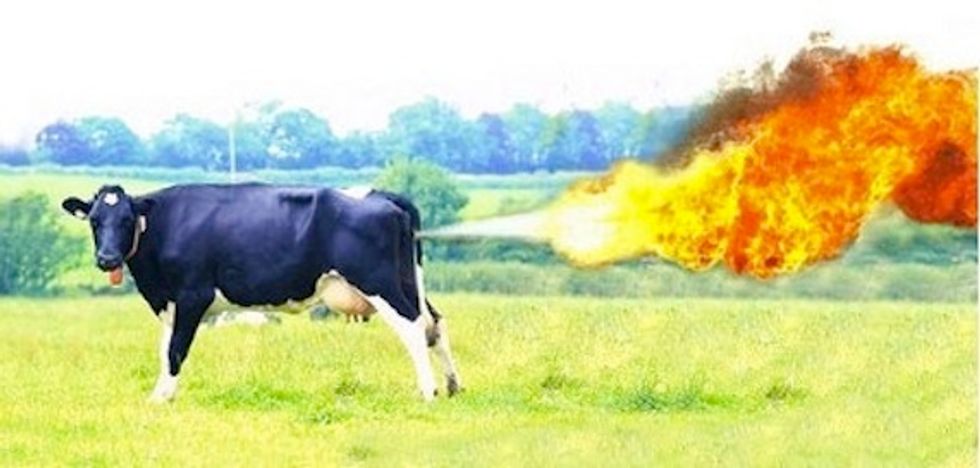There are currently 1.2 billion cows on the planet. Naturally, I wondered how much environmental impact they are having. A Japanese study showed that producing a kilogram of beef leads to the emission of greenhouse gases with a global warming potential equivalent to 36.4 kilograms of carbon dioxide (CO2). I then wondered how this compared to parking.
A year-long study conducted in 2007 by researchers at UCLA in a small fifteen block district in Los Angeles found that people drove close to one million miles, produced one and a half million pounds of carbon dioxide, and used almost 50,000 gallons of gas, not getting to their destination, but after having already arrived…and then circling in search for parking.
U.S. vehicles were the second largest source of America’s greenhouse gases. Tailpipes produced 1.2 billion metric tons (2.6 trillion pounds) of carbon dioxide from burning gasoline.
Carbon dioxide is not necessarily a bad thing. You and I produce about two pounds of carbon dioxide per day just by exhaling. The amount of carbon dioxide taken out of the atmosphere by plants and trees is almost perfectly balanced by the amount produced by respiration and decay. In this cycle, new carbon doesn’t really enter the system, it just keeps changing forms. It’s a normal and healthy functioning system.
Carbon dioxide from cars is the same gas that is produced by us by breathing. But, when one substance is present in excess it threatens the well-being of an ecosystem. It becomes toxic.
CO2 is toxic in our ecosystem because the excess can’t be absorbed by plants and trees fast enough. And, as a molecular structure with mass that gets trapped and waits to be absorbed by trees, the carbon dioxide molecules collect heat from the sun–thus making our climate increase in heat. This increase in heat then triggers ice caps melting and voila…global warming.
Over the last few months I have monitored myself to see just how long it takes for the concept of global warming to enter my mind and then to leave my mind. It didn’t stick around very long initially. Thinking about not being able to breathe and massive flooding are not my favorite topics to dwell upon, so my mind quickly took me to more pleasant topics like baseball, whiskey, women, and chocolate. This is a natural human defense mechanism, because we feel that there is nothing we individually can do to stop it. So, poof…on to the nearest distraction.
But after a while, defense mechanisms stop being effective.
Most people can’t (and don’t want to) begin to comprehend a topic like irreversible global warming. If I read or wrote 33 trillion tons as opposed to 33 billion tons, the difference wouldn’t have mattered–it’s just too big.
Whenever I'm faced with something incomprehensible, I like to break it down to a manageable size so that I can begin to wrap my brain around it.
Based on the aforementioned UCLA study results, I crunched the numbers to see just what we are up to here in San Francisco carbon-wise.
Brace yourself.
828 million miles are driven per year in San Francisco, just in search of parking.
41 million gallons of gas are consumed per year while looking for parking in San Francisco.
1.3 billion pounds (635,000 tons) of global warming gases are emitted into the atmosphere in San Francisco per year…not while driving to a destination, but once we’ve already arrived…and are circling in search of parking.
This was difficult for me to believe, so I did a comparison. The average car drives 10,000 miles per year .Ten thousand miles x 505,000 vehicles in SF = five billion total miles driven per year by SF vehicles. The math is correct.
The stopping, starting, and idling involved in looking for parking is the mode in which vehicles are the most inefficient and polluting.
Now, for some good news.
The average time it takes to park in San Francisco is 6.5 minutes. Using VoicePark along with SFPark’s growing and evolving web of sensors in the streets, the average time that it now takes to park is less than 45 seconds. This time saved (while easing stress and anxiety) prevents two-plus pounds of carbon dioxide from entering the atmosphere per parking episode.
If just half of the City’s 505,000 vehicles parked more efficiently using the SFPark sensor and VoicePark app system, once per day, we would prevent over 1 million pounds of carbon dioxide from entering the system each day.
It seems we are at a place where technology actually may be the sustainable solution we hoped it could be, and it can begin to correct the problems that the industrial age created. Simply by parking more efficiently, collectively, we can actually make a dramatic difference. One parking spot at a time.
Pass it on.
To see VoicePark in action check out Extreme Parking on June 11 on the Travel Channel. David LaBua has been researching the phenomenon of parking for the last decade. He is the author of the book Finding the Sweet Spot and founder of VoicePark, the app that easily guides drivers by voice to the closest available parking spot on-street and off-street.





















